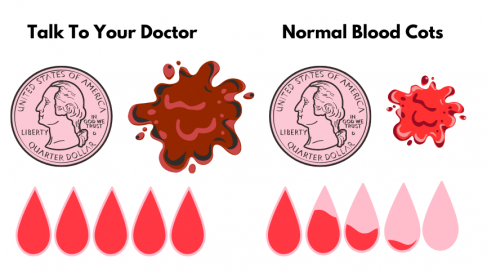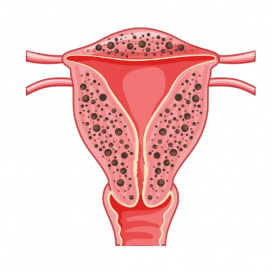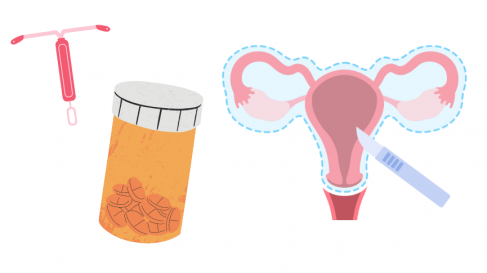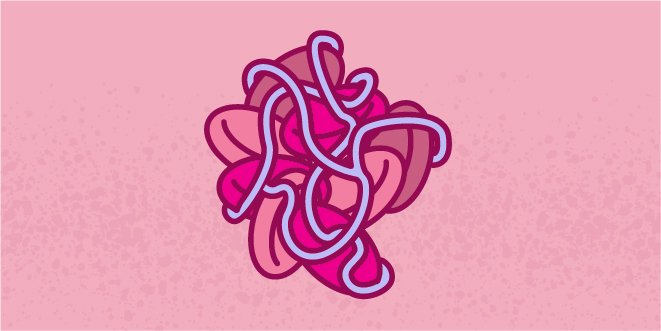Despite the fact that there is a month in and month out period, there are still some questions that remain unanswered about this time of the month.
This could be partly because one did not receive sufficient (or any) education about the menstrual cycle at home or at school, or because one notices something during “that time of the month” that is unusual or perhaps even frightening.
Like menstrual clots – are they normal and why do they happen?
During your monthly period, you uterine the lining is shed which means blood is expelled through it sinus.
This lining consists of blood, blood by-products, mucus and tissue.
This blood and tissue is quite thick, so the body releases anticoagulants that help thin the blood to make it easier to pass through.
But, if your blood flow exceeds your body’s ability to produce anticoagulants, menstrual clots occur.
As Salena ZanottiMD, says:
“Blood clots will form whenever you have a certain amount of blood sitting there. Blood clots are supposed to happen to some degree, like when you cut yourself. But with period clots, what happens is if you have enough bleeding, it collects inside your uterus and as it sits there it will form a clot.”
If you’re someone who experiences menstrual clots, it’s a good idea to see a specialist if:
- You pass many blood clots that are larger than a quarter
- You have heavy menstrual bleeding (change tampons or pads every two hours or less) for several hours
“Normal blood clots are usually:
- Smaller than a quarter
- Rare
- It happens near the start of your period
- Intense or dark red in appearance

Underlying causes of menstrual clots
Now that we know what happens inside the body when menstrual clots form and are released, are there any underlying causes we should be aware of?
Indeed, there are some natural and hormonal factors that can affect blood flow and the formation of blood clots.
Obstructions of the uterus
If someone has a condition that enlarges the uterus, additional pressure could be placed on the uterine wall. This could lead to heavier menstrual bleeding and clots.
Obstructions can also affect the uterus’ ability to contract. This means that it will take longer for the blood to leave the vagina to start pooling in the uterine cavity and forming clots.
Hormone imbalance
Throughout the menstrual cycle, hormones are constantly changing, rising and falling. That doesn’t mean there is one imbalance however. In fact, this combination of hormonal changes makes the perfect situation for conception.
But if someone suffers from an imbalance of hormones (perhaps from conditions such as perimenopausestress, significant weight loss or gain), then there could be a change in how much blood is expelled and whether or not it forms clots.
Adenomyosis
This condition causes the lining of one’s uterus to grow into the muscular wall of the uterus. And when it does, the uterus can grow up to two to three times its normal size.


During adenomyosis, the endometrial lining and uterine wall may be much thicker than normal. This, in turn, can lead to heavier periods and blood clotting.
Enlarged uterus
If someone has a bigger one matrix (often after pregnancy), has more room for blood to pool before being expelled.
This means that blood clots can form as the blood sits inside the uterus, waiting to leave the body.
Failure
In the unfortunate event of a failureit is common to pass a lot of blood and blood clots.
But if a person doesn’t know they’re pregnant, they might just think it’s a heavy period.
Thyroid issues
Your thyroid is a gland in your neck that is responsible for producing and distributing hormones. Thus, if one experiences a thyroid conditionit can mean chaos for their menstrual cycle.


Some thyroid conditions include hyperthyroidism and hypothyroidism (when the body produces too much or too little thyroid hormone).
Endometriosis
Endometriosis it affects about 10% of women worldwide. It is a condition that causes the tissue lining the uterus to grow outside the uterus.
If someone is living with endometriosis, they may experience heavier and more painful periods that are accompanied by blood clots.
How to diagnose menstrual clots
If you frequently experience period clots that are larger than a quarter, the first step would be to see your healthcare provider.
They will ask you many questions about your cycle as well as things that may affect your cycle.
For example, you may be asked if you’ve ever had pelvic surgery if you use contraceptionor if you have ever become pregnant.
After that, they may do some blood tests to look for any hormonal imbalances. And/or they may perform an imaging test (such as an MRI or ultrasound).
How to treat period clots
There are a few solutions that can be effective in reducing or stopping menstrual clots:


- Hormonal contraceptives: If someone is taking hormonal contraceptives, the growth of the lining of the uterus could be inhibited. An intrauterine device (IUD), for example, can reduce the amount of period blood by up to 90%. And the birth control pill could reduce it by as much as 50%.
- Medication: The drug belonging to the class of drugs known as antifibrinolytics could have a positive effect on period coagulation. A health care provider may also suggest that you take non-steroidal anti-inflammatory drugs, which can help with less bleeding and more comfort.
- Surgery: A dilation and curettage procedure (D and C) is sometimes done after the birth of the child or a miscarriage. It can also be done as a means to discover the cause of heavy menstruation and blood clots. This procedure will not cure heavy bleeding, but it could provide less bleeding for a few months. Another surgery that some may choose is a hysterectomy. This is when the uterus is removed and one will not be able to conceive or have monthly periods.
So while period clots can be a cause for concern, there are a few ways a professional could help.
The bottom line; If you start to notice that your periods are becoming much heavier or that you are experiencing (more) large blood clots, it is recommended that you seek medical treatment.
